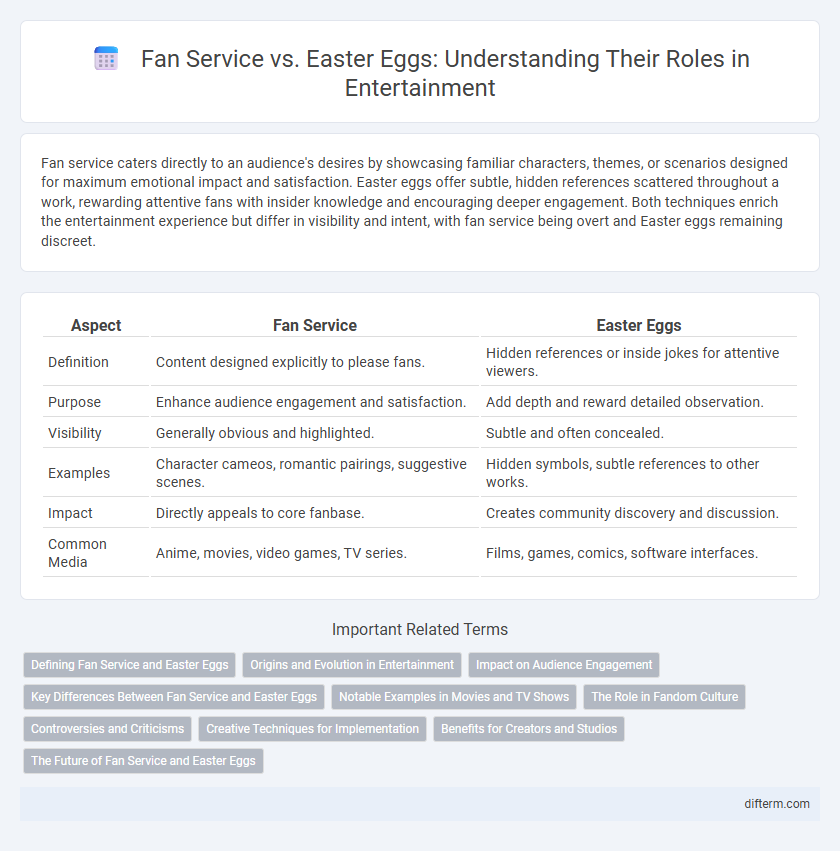Fan service caters directly to an audience's desires by showcasing familiar characters, themes, or scenarios designed for maximum emotional impact and satisfaction. Easter eggs offer subtle, hidden references scattered throughout a work, rewarding attentive fans with insider knowledge and encouraging deeper engagement. Both techniques enrich the entertainment experience but differ in visibility and intent, with fan service being overt and Easter eggs remaining discreet.
Table of Comparison
| Aspect | Fan Service | Easter Eggs |
|---|---|---|
| Definition | Content designed explicitly to please fans. | Hidden references or inside jokes for attentive viewers. |
| Purpose | Enhance audience engagement and satisfaction. | Add depth and reward detailed observation. |
| Visibility | Generally obvious and highlighted. | Subtle and often concealed. |
| Examples | Character cameos, romantic pairings, suggestive scenes. | Hidden symbols, subtle references to other works. |
| Impact | Directly appeals to core fanbase. | Creates community discovery and discussion. |
| Common Media | Anime, movies, video games, TV series. | Films, games, comics, software interfaces. |
Defining Fan Service and Easter Eggs
Fan service refers to deliberate content created to please dedicated fans, often through suggestive scenes, character cameos, or references directly appealing to a fandom's desires. Easter eggs are subtle, hidden details or inside jokes embedded within entertainment media that reward attentive viewers with deeper connections or plot insights. Both elements enhance fan engagement, but fan service is overt and targeted, while Easter eggs require discovery and interpretation.
Origins and Evolution in Entertainment
Fan service originated in Japanese anime and manga during the 1970s as deliberate content designed to please loyal viewers, often through exaggerated character features or suggestive scenes. Easter eggs trace back to the 1980 Atari game Adventure, where hidden messages and secret rooms were embedded to reward attentive players, evolving into subtle nods across films, video games, and TV shows. Both concepts have evolved to deepen audience engagement, with fan service catering directly to fan desires while Easter eggs create layered intertextuality and insider recognition in entertainment media.
Impact on Audience Engagement
Fan service boosts audience engagement by delivering immediate gratification through familiar characters, scenes, or references that resonate with dedicated fans. Easter eggs encourage deeper exploration and repeated viewings as viewers actively seek hidden clues or subtle nods, fostering a stronger connection with the content. Both techniques enhance fan loyalty but cater to different engagement styles: fan service provides overt recognition while Easter eggs reward attentive and knowledgeable audiences.
Key Differences Between Fan Service and Easter Eggs
Fan service targets the audience by including explicit content, character interactions, or scenes designed to please dedicated fans, often emphasizing visual appeal or emotional gratification. Easter eggs are subtle references or hidden messages embedded within a work, rewarding observant viewers without disrupting the narrative flow. Unlike fan service, which is overt and intended to engage or excite fans directly, Easter eggs function as clever nods that add depth and encourage exploration.
Notable Examples in Movies and TV Shows
Notable examples of fan service include the Marvel Cinematic Universe's frequent character cameos and references designed to please dedicated fans, such as Stan Lee's appearances. Easter eggs are hidden references like the "Pizza Planet" truck appearing in almost every Pixar film or the "Red Room" symbol in Stranger Things, which hint at deeper lore or connections. Both techniques enrich viewer engagement but differ as fan service directly caters to audience expectations, while Easter eggs reward attentive fans with subtle storytelling layers.
The Role in Fandom Culture
Fan service enhances engagement by directly catering to fans' desires with explicit references or favored character moments, strengthening emotional connections and loyalty. Easter eggs reward attentive viewers through subtle, hidden details that create a sense of discovery and community among fans sharing discoveries. Both elements enrich fandom culture by fostering interaction, discussion, and deeper investment in a franchise's universe.
Controversies and Criticisms
Fan service often draws criticism for prioritizing shallow gratification over narrative integrity, leading to accusations of pandering and disrupting plot coherence. Easter eggs, while generally celebrated for rewarding dedicated fans, can face controversy when perceived as exclusionary or overly obscure, alienating casual viewers. Both elements spark debate about balancing creative storytelling with audience engagement in entertainment media.
Creative Techniques for Implementation
Fan service and Easter eggs are distinct creative techniques used in entertainment to engage audiences; fan service directly caters to audience desires with recognizable content, while Easter eggs provide subtle, hidden references that reward attentive viewers. Effective implementation involves balancing overt appeal in fan service without overshadowing the narrative, whereas Easter eggs require thoughtful integration that enhances replay value and deepens lore appreciation. Studios like Marvel and anime productions exemplify mastery in embedding Easter eggs and fan service to enrich viewer experience and maintain franchise loyalty.
Benefits for Creators and Studios
Fan service enhances audience engagement by directly appealing to loyal fans through recognizable characters, references, or scenes, boosting viewership and merchandise sales. Easter eggs reward attentive viewers with hidden details that encourage deeper exploration and repeated consumption, fostering community discussions and increasing content longevity. Both techniques strengthen brand loyalty and contribute to a franchise's cultural footprint, driving sustained revenue for creators and studios.
The Future of Fan Service and Easter Eggs
Fan service and Easter eggs will increasingly shape audience engagement through immersive storytelling and interactive content in future entertainment media. Advanced technologies like augmented reality (AR) and virtual reality (VR) are expected to enhance the discovery of Easter eggs, creating personalized fan experiences that deepen emotional connections. As franchises expand across multiple platforms, tailored fan service will evolve to maintain loyalty and generate viral online communities.
Fan service vs Easter eggs Infographic

 difterm.com
difterm.com